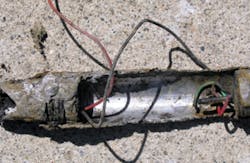We have all experienced the frustration of working on a project and discovering that something is not working, does not fit, or keeps breaking. What is even worse is to be told by a supplier that the problem part seems to be working properly. Inevitably we come away with yet another "if only I would have …" to add to our own personal experience.
There are many things to consider when selecting a pressure sensor for a given application—so many, in fact, that it can be easy to overlook key elements until after it is too late. Nearly a decade of working with pressure sensors and various applications has convinced me that this is the most common reason for problems in the field. Even veterans in the industry fall into this trap from time to time.
Here are 15 fundamentals to consider when selecting a pressure sensing device:
1. Range: The pressure range is perhaps the most fundamental of all considerations when selecting a pressure transducer. Typically, the highest pressure a sensor is likely to experience is considered the pressure range required for the application–the full-scale pressure range of the sensor.
2. Pressure type: There are several pressure types to consider, but they can all be divided into two broad categories–vented and sealed. Vented pressure types use atmospheric pressure as the reference point, or the zero point. Sealed sensors have a sealed reference point that everything is measured against.
3. Output: An array of output options is available. Your choice depends on whether the sensor is used in conjunction with a controller, or is a stand-alone unit. If using a controller, make sure it can handle the output offered by the sensor manufacturer.
4. Accuracy: While price is not actually one of the considerations addressed in this article, accuracy is perhaps the key factor in driving the cost of a pressure transmitter. The higher the accuracy required, the higher the cost. By carefully examining what accuracy is required for the application, you are, in fact, limiting the expense of your project.
5. Resolution: This is an often over-looked consideration because it is not universally applicable. Resolution is impaired when down ranging a sensor as we previously discussed. You may end up requesting this, but it can also happen when you need a custom pressure range outside the standard offering of the manufacturer.
6. Life cycle: How long do you need the sensor to work? If the sensor will be used in short-term applications, more options are available than if a sensor needs to perform within specification for an extended period of years.
7. Over-pressure ratings: In an ideal world, an over-pressure rating would not be necessary, but the reality is that it does occur. It is, therefore, better to be safe than sorry.
8. Process connections: This seems like common sense, but you would be surprised how many times I have seen and heard of people trying to get a sensor to fit in a pressure port it was not designed to fit.
9. Application environment: Will the sensor be used indoors or outdoors, or in a wash down area? Is it mounted in an electrically noisy area, such as near pumps or motors? Ensure the sensor housing and cable offer protection for these environmental factors.
10. Temperature compensation: The compensated range is the temperature range wherein the sensor will remain in spec. This is different from operational or storage temperature.
11. Chemical compatibility: Also called material compatibility, this refers to the existence and severity of a chemical reaction between the sensor material and the media being measured.
12. Required approvals: Regulated environments require specific approvals, or certifications. For example, the oil and gas industry requires hazardous location approvals to comply with safety regulation and to prevent an explosion.
13. Quality: There are a few indicators of product quality. For example, a company’s longevity and reputation can tell you a lot about their product.
14. Lead time: More than anything else, lead times can cause you to make a concession or two with sensor specifications. Do the best you can to plan in advance and avoid a sensor change-up at the last minute.
15. Technical support: When all is said and done, even with all considerations accounted for, problems can still arise. You’ll need good tech support that can walk you through the issue.
While fairly basic, each of the above points is critical to consider before making a selection that will work effectively for your application.
This post is based on a more detailed feature article that will appear in the January issue of Flow Control magazine. For a more detailed checklist for pressure sensor selection, please read the January issue. If you are not yet a subscriber to Flow Control magazine, you can register for a free subscription here.
Elden Tolman is a product development engineer at Automation Products Group, Inc. (APG, www.apgsensors.com). After earning a bachelor’s degree in Engineering from Utah State University, Mr. Tolman has worked at APG for nine years. Currently he manages nine product lines, with hundreds of options ranging from outputs to process connections. He actively provides technical support to a range of large end-user companies in various industries. Mr. Tolman can be reached at 435 753-7300 or [email protected].


